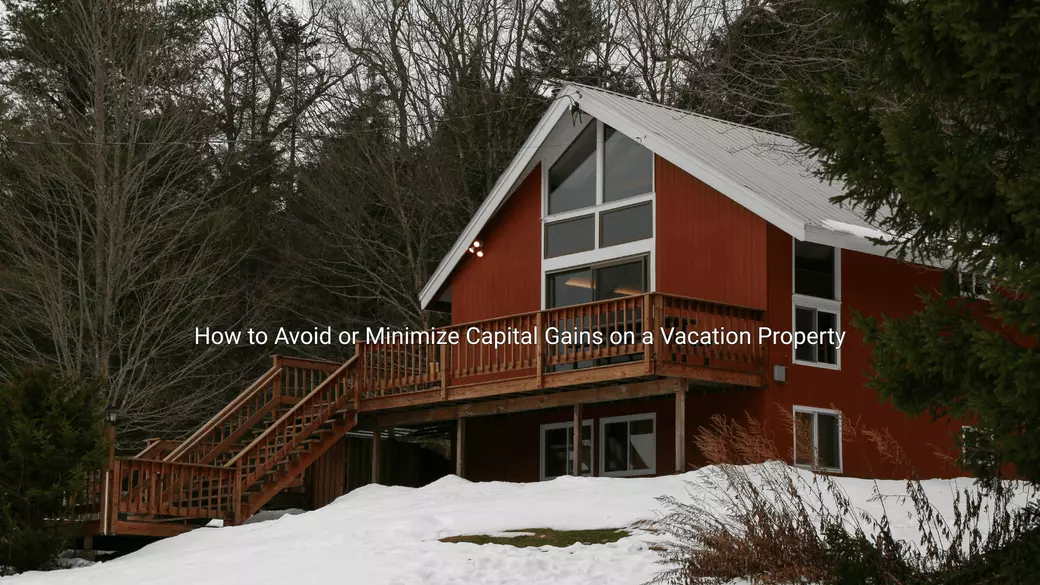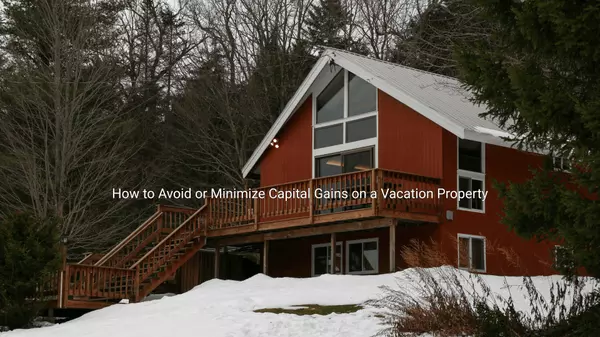How to Avoid or Minimize Capital Gains on a Vacation Property

Owning a vacation property can be a dream come true, offering a personal retreat and potential rental income. However, when it comes time to sell, capital gains tax (CGT) can take a significant bite out of your profits. In the United States, capital gains tax applies to the profit made from selling a property that has appreciated in value. For a vacation property, which is typically considered a second home or investment property, the tax implications can be substantial. Fortunately, there are several strategies to avoid or minimize capital gains tax. Below, we explore these options, keeping in mind that tax laws are complex and consulting a tax professional is essential for personalized advice.
Understanding Capital Gains Tax on Vacation Properties
Capital gains tax is levied on the profit from selling an asset, such as a vacation home, calculated as the difference between the sale price and your adjusted basis (purchase price plus improvements, minus depreciation if applicable). In 2025, long-term capital gains (for assets held over one year) are taxed at 0%, 15%, or 20% for federal taxes, depending on your income, with an additional 3.8% Net Investment Income Tax (NIIT) for high earners. State taxes may also apply, varying by location.
Vacation properties don’t qualify for the primary residence exclusion (up to $250,000 for single filers or $500,000 for married couples filing jointly), which makes strategic planning critical to reduce tax liability. Here are proven strategies to consider:
1. Hold the Property for Over One Year
To qualify for lower long-term capital gains tax rates (0%, 15%, or 20%) instead of higher short-term rates (taxed as ordinary income), hold your vacation property for at least one year. This simple strategy can significantly reduce your tax burden, especially if you’re in a higher income bracket.
Example: If you buy a vacation home for $300,000 and sell it for $400,000 after 18 months, your $100,000 gain is taxed at the long-term rate (e.g., 15% for many taxpayers, or $15,000). If sold within a year, the gain could be taxed at your ordinary income rate, potentially 24% or higher ($24,000+).
2. Offset Gains with Capital Losses
You can reduce or eliminate capital gains by offsetting them with capital losses from other investments, such as stocks, bonds, or other real estate. This strategy, known as tax-loss harvesting, allows you to deduct losses against gains, potentially lowering your taxable gain to zero.
How It Works: If you sell your vacation property for a $50,000 gain but have $30,000 in losses from selling stocks, your taxable gain drops to $20,000. If losses exceed gains, you can deduct up to $3,000 annually against ordinary income, carrying over excess losses to future years.
Tip: Review your investment portfolio before selling the property to identify assets with unrealized losses that can be sold strategically.
3. Use a 1031 Exchange
A 1031 exchange, named after Section 1031 of the IRS Code, allows you to defer capital gains tax by reinvesting the proceeds from the sale of your vacation property into a “like-kind” property of equal or greater value. This strategy is particularly effective for investment properties, but vacation homes may qualify if used primarily for rental purposes rather than personal use.
Key Requirements:
- The replacement property must be of equal or greater value.
- Both properties must be held for investment or business purposes (personal-use vacation homes may not qualify unless rented out significantly).
- You must identify the replacement property within 45 days and close within 180 days.
- A qualified intermediary must handle the transaction to avoid receiving the proceeds directly.
Example: You sell a vacation home for $500,000 with a $200,000 gain. By reinvesting the full proceeds into another rental property, you defer the entire tax liability until you sell the new property without a 1031 exchange.
Note: Strict IRS rules apply, so work with a qualified intermediary and tax advisor to ensure compliance.
4. Offer Seller Financing
Seller financing has many advantages. It defers your income and therefore your tax liability and it also creates a stream of income.
5. Convert the Vacation Property to Your Primary Residence
While vacation properties don’t qualify for the primary residence exclusion, you can convert your vacation home into your primary residence to take advantage of the $250,000/$500,000 exclusion. To qualify, you must live in the property as your primary residence for at least two of the five years before selling it.
Strategy:
Move into the vacation home and make it your primary residence for at least two years.
After meeting the two-year requirement, sell the property and exclude up to $250,000 (single) or $500,000 (married filing jointly) of the gain from taxes.
Limitations:
- Only the gain attributable to the period after 2008 (when tax rules changed) qualifies for the exclusion if the property was previously a second home.
- The exclusion is prorated based on the time the property was used as a vacation home versus a primary residence.
Example: You own a vacation home for 10 years, live in it as your primary residence for two years, then sell it for a $300,000 gain. A portion of the gain may be excluded, depending on the time spent as a non-primary residence.
6. Maximize Your Adjusted Basis
Reducing your taxable gain involves increasing your adjusted basis, which lowers the difference between the purchase price and sale price. Keep detailed records of all capital improvements, such as renovations, additions, or upgrades, as these increase your basis.
- Examples of Improvements:
- Adding a deck or pool.
- Renovating the kitchen or bathrooms.
- Installing a new roof or HVAC system.
Example: You buy a vacation home for $250,000, spend $50,000 on renovations, and sell it for $400,000. Your adjusted basis is $300,000, so your taxable gain is $100,000 instead of $150,000.
Tip: Maintain receipts and documentation for all improvements, as the IRS may request proof during an audit.
7. Gift or Bequeath the Property
If you don’t need to sell the property during your lifetime, consider gifting it or passing it to heirs through your estate. Both strategies can minimize or eliminate capital gains tax:
Gifting: If you gift the property to a family member or charity, you avoid capital gains tax on the sale. However, the recipient inherits your basis, so they may face capital gains tax if they sell it later.
Bequeathing: If the property is passed to heirs upon your death, they receive a “step-up in basis” to the property’s fair market value at the time of your death. This eliminates capital gains tax on appreciation that occurred during your lifetime.
Example: You bought a vacation home for $200,000, and it’s worth $500,000 at your death. Your heir’s basis is $500,000, so if they sell it for $500,000, they owe no capital gains tax.
Caution: Gifting or bequeathing may trigger estate or gift taxes, depending on the property’s value and your estate size. Consult an estate planning professional.
8. Use an Opportunity Zone Investment
Investing your capital gains in a Qualified Opportunity Zone (QOZ) fund can defer and potentially reduce capital gains tax. This program, designed to encourage investment in economically distressed areas, offers tax benefits for reinvesting gains within 180 days of the sale.
Benefits:
- Defer capital gains tax until December 31, 2026, or when you sell the QOZ investment.
- Reduce taxable gain by 10% if held for five years, or 15% if held for seven years.
- Eliminate tax on new gains if the QOZ investment is held for 10 years.
Consideration: This strategy requires careful planning, as QOZ investments carry risks and specific requirements. Consult a financial advisor.
9. Rent Out the Property to Qualify for Business Deductions
If your vacation home is used primarily as a rental property, you may qualify for business-related deductions such as depreciation, maintenance, and operating expenses, which can lower your overall tax liability.
Example: You rent out your vacation home for 180 days annually and claim depreciation deductions over several years. This lowers your basis, but when paired with a 1031 exchange or other strategies, it can optimize your tax outcome.
Note: The IRS has strict rules on rental property classification (e.g., personal use limited to 14 days or 10% of rental days). Work with a tax professional to ensure compliance.
Key Considerations and Next Steps
Each of these strategies has specific IRS rules, deadlines, and eligibility criteria. The best approach depends on your financial situation, the property’s use (personal vs. rental), and your long-term goals. Always consult a qualified tax professional or financial advisor to tailor these strategies to your circumstances and ensure compliance with current tax laws.
By planning ahead and leveraging these options, you can significantly reduce or even eliminate capital gains tax on your vacation property, preserving more of your hard-earned profits.
Recent Posts







GET MORE INFORMATION


